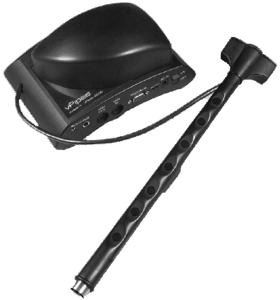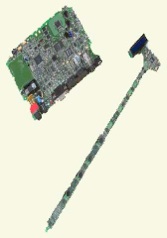— Its responsiveness is amazing, said Tim Dowd, one of the most known Irish pipers and flute players in the London area (Along with his father Tim Dowd senior, who invited Ramon to the Cultural Centre). Tim jr wasn’t the only one there who liked give the vPipes a try.
— The thing that strikes you in particular is how well they respond to all the normal piping stuff — tight triplets, slides, vibrato, popping. Everything sounds just as it should and you don't have to adjust your technique at all. The chanter feels really natural to play and you very quickly forget it's an electronic instrument, said Sam Thompson.
It was smiles all over.
The vPipes sound is in fact very close to the original, it really sounds like the "real thing" — not suprising given the fact that the samples stem from the very best material: Cillian Vallely sampling his Rowsome and Froment flat and concert pitch sets.

In a concert situation you would be able to change pitches as easily as pressing a button. Just choose the preset for that particular song your about to play and you’re ready to go. Or rather play.
And of course you can connect it to headphones avoiding disturbing anyone else while practising.
So what then made Ramon and his friend José “reinvent” the uilleann pipes?
— We were both interested in learning to play the UP, but we couldn’t practise at home. We both have families and we wanted to be able to practise without disturbing them.
How long did it take from idea to the real thing?
— About two years. Its started as a hobby and then it went on from there.
Many have seen the web site and the clips on YouTube, but when will it be on the market?
—As soon as possible, but we haven’t set a date not to make people disappointed if we don’t manage to make it to that date. Also, as a small company, we can’t afford to not get it right the first time, so we are putting a lot of time and effort into it.
Ramon points out several times during the evening that the vPipes was not made to replace the real thing:
— It’s a tool for learning, backup etc, he stresses.
As Ramon offers his vision of learning this rather difficult instrument without disturbing family members etc I strongly wish he would have invented one when I still lived at home. I would happily have bought my dad one or two...
Also, Ramon points out the possibility of having the vPipes as a backup at concerts etc. Where a real bagpipe can let you down (just a change of humidity could to that, at least for the UP) the vPipes will not.

— To emulate the sounds and making it behave like real pipes.
A MIDI—OUT is fine, the MIDI—IN is even more exciting. Does this mean that the vPipes will work as an sound box for an outboard keyboard or wind controller like a Yamaha WX-7?
— No, it cannot function as a sound box. Although it could technically be possible, what gives the vPipes its realism is the possibility of controlling the sound just like on the real instrument. The MIDI-IN connector is there because it is required for programming the sound banks which, among other things leaves the possibility open of adding regulators in the future.
How do you play semitones without keys?
— The piper has to half-hole although we are considering using the rear touchpad to act as keys in the future, nothing has yet been decided.
How does the bag pressure simulator work when playing, is the simulator the only way to change to the 2nd octave?

good fingering)
Will the gaita, ghb etc versions be based on the UP-version (i e just changing the samples) or will you change the whole chanter design?
— We will be making a new chanter design to cover the non-uilleann pipes.

As the evening went on and more pipers tried out the vPipes the general opinion was that Ramon and José really have succeeded in making an electronic UP. Now, it’s just the wait to get them out on the market, some of them said.
How much are the vPipes? Ramon offers some hope for those with a tight budget:
— Right now the price is around 980€, which is
about 600£. We would like to bring the price
down, but there are factors, like the price on
components, which we don't control. I'd like to
stress however that we are not in it for the
money, this did not start as a money making business.
For those out there in the Swedish wilderness hoping to meet Ramon in Sweden there are no plans for a
Sweden trip — so far. But most of the information can be found at www.vpipes.com , where you can also hear sound samples. On YouTube there are 5-6 clips with the vPipes, see the vPipes link page

Anneli Winter in London for www.piping.se.
Additional material by Jan Winter and the vPipes project .




